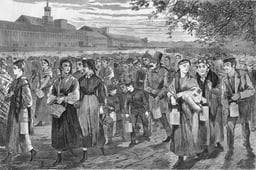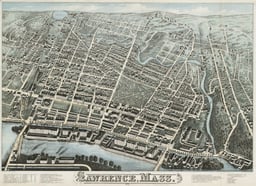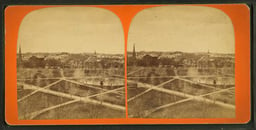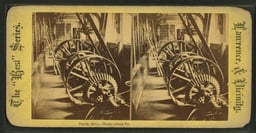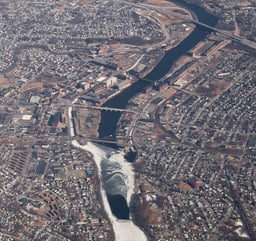Lawrence, Massachusetts
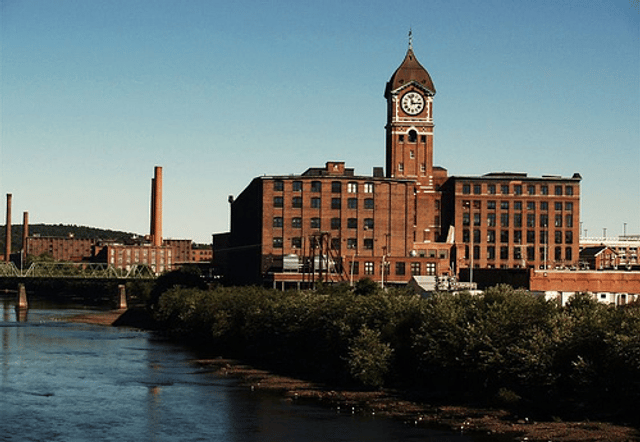
Lawrence, Massachusetts

Lawrence, Massachusetts | |
|---|---|
City | |
| Motto(s): Industria(Latin) "Industry" | |
 Location in Essex County and the state of Massachusetts. | |
| Coordinates:42°42′25″N 71°09′49″W [153] | |
| Country | |
| State | |
| County | Essex |
| Region | New England |
| Settled | 1655 |
| Incorporated | 1847 |
| Incorporated (city) | 1853 |
| Government | |
| • Type | Mayor-council city |
| • Mayor | Dan Rivera (D) |
| • City Council President | Kendrys Vasquez |
| Area | |
| • Total | 7.4 sq mi (19.2 km2) |
| • Land | 6.9 sq mi (17.9 km2) |
| • Water | 0.5 sq mi (1.2 km2) |
| Elevation | 16 ft (5 m) |
| Population (2010) | |
| • Total | 76,377 |
| • Estimate (2018)[1] | 80,376 |
| • Density | 11,618/sq mi (4,486/km2) |
| Time zone | UTC−5 (Eastern) |
| • Summer (DST) | UTC−4 (EDST) |
| ZIP code | 01840, 01841, 01842, 01843 |
| Area code(s) | 351 / 978 |
| FIPS code | 25-34550 |
| Website | www.cityoflawrence.com [154] |
| Lawrence Public Schools | |
| Location | |
| 233 Haverhill Street, Lawrence, MA 01840 United States | |
| District information | |
| Type | Public |
| Grades | K-12 |
| Superintendent | Cynthia Paris[80] |
| Schools | 32 |
| Budget | $200,571,691 total $13,852 per pupil[81] |
| Students and staff | |
| Students | 13,889[82] |
| Teachers | 1,052[83] |
| Student-teacher ratio | 12.8 to 1[83] |
| Other information | |
| Website | Lawrence Public Schools [155] |
Lawrence is a city in Essex County, Massachusetts, United States, on the Merrimack River. As of the 2010 census, the city had a population of 76,377,[2] which had risen to an estimated 78,197 as of 2014.[3] Surrounding communities include Methuen to the north, Andover to the southwest, and North Andover to the southeast. Lawrence and Salem were the county seats of Essex County, until the Commonwealth abolished county government in 1999.[4] Lawrence is part of the Merrimack Valley.
Manufacturing products of the city include electronic equipment, textiles, footwear, paper products, computers, and foodstuffs. Lawrence was the residence of poet Robert Frost for his early school years; his essays and poems were first published in the Lawrence High School newspaper.[5]
Lawrence, Massachusetts | |
|---|---|
City | |
| Motto(s): Industria(Latin) "Industry" | |
 Location in Essex County and the state of Massachusetts. | |
| Coordinates:42°42′25″N 71°09′49″W [153] | |
| Country | |
| State | |
| County | Essex |
| Region | New England |
| Settled | 1655 |
| Incorporated | 1847 |
| Incorporated (city) | 1853 |
| Government | |
| • Type | Mayor-council city |
| • Mayor | Dan Rivera (D) |
| • City Council President | Kendrys Vasquez |
| Area | |
| • Total | 7.4 sq mi (19.2 km2) |
| • Land | 6.9 sq mi (17.9 km2) |
| • Water | 0.5 sq mi (1.2 km2) |
| Elevation | 16 ft (5 m) |
| Population (2010) | |
| • Total | 76,377 |
| • Estimate (2018)[1] | 80,376 |
| • Density | 11,618/sq mi (4,486/km2) |
| Time zone | UTC−5 (Eastern) |
| • Summer (DST) | UTC−4 (EDST) |
| ZIP code | 01840, 01841, 01842, 01843 |
| Area code(s) | 351 / 978 |
| FIPS code | 25-34550 |
| Website | www.cityoflawrence.com [154] |
| Lawrence Public Schools | |
| Location | |
| 233 Haverhill Street, Lawrence, MA 01840 United States | |
| District information | |
| Type | Public |
| Grades | K-12 |
| Superintendent | Cynthia Paris[80] |
| Schools | 32 |
| Budget | $200,571,691 total $13,852 per pupil[81] |
| Students and staff | |
| Students | 13,889[82] |
| Teachers | 1,052[83] |
| Student-teacher ratio | 12.8 to 1[83] |
| Other information | |
| Website | Lawrence Public Schools [155] |
History
Founding and rise as a textile center
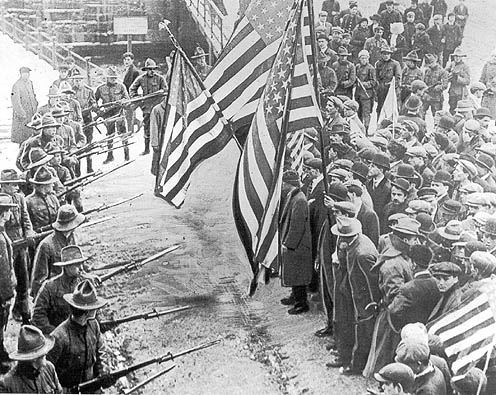
1912 Lawrence textile strike, Massachusetts National Guardsmen with fixed bayonets surround a parade of strikers.
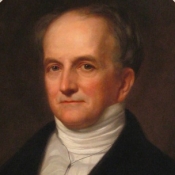
Portrait of Ambassador Abbott Lawrence by G.P.A. Healy
Native Americans, namely the Pennacook or Pentucket tribe, had a presence in this area. Evidence of farming at Den Rock Park and arrowhead manufacturing on the site of where the Wood Mill now sits have been discovered.[6]
Europeans first settled the Haverhill area in 1640, colonists from Newbury following the Merrimack River in from the coast.[7] The area that would become Lawrence was then part of Methuen and Andover. The first settlement came in 1655 with the establishment of a blockhouse in Shawsheen Fields, now South Lawrence.
The future site of the city (formerly parts of Andover and Methuen), was purchased by a consortium of local industrialists. The Water Power Association members: Abbott Lawrence, Edmund Bartlett, Thomas Hopkinson of Lowell, John Nesmith and Daniel Saunders, had purchased control of Peter's Falls on the Merrimack River and hence controlled Bodwell's Falls the site of the present Great Stone Dam. The group allotted fifty thousand dollars to buy land along the river to develop.[8] [] In 1844, the group petitioned the legislature to act as a corporation, known as the Essex Company, which incorporated on April 16, 1845. The first excavations for the Great Stone Dam to harness the Merrimack River's water power were done on August 1, 1845.[8] [] The Essex Company would sell the water power to corporations such as the Arlington Mills, as well as organize construction of mills and build to suit. Until 1847, when the state legislature recognized the community as a town, it was called interchangeably the "New City", "Essex" or "Merrimac".[8] [] The post office, built in 1846, used the designation "Merrimac". Incorporation as a city would come in 1853, and the name "Lawrence", merely chosen as a token of respect to Abbott Lawrence, who it cannot be verified ever saw the city named after him.
Canals were dug on both the north and the south banks to provide power to the factories that would soon be built on its banks as both mill owners and workers from across the city and the world flocked to the city in droves; many were Irish laborers who had experience with similar building work. The work was dangerous: injuries and even death were not uncommon.[9]
The Bread and Roses Strike of 1912
Working conditions in the mills were unsafe and in 1860 the Pemberton Mill collapsed, killing 145 workers.[10] As immigrants flooded into the United States in the mid to late 19th century, the population of Lawrence abounded with skilled and unskilled workers from several countries.
Lawrence was the scene of the infamous Bread and Roses Strike, also known as the Lawrence Textile Strike, one of the more important labor actions in American history.
Post-War history
Lawrence was a great wool-processing center until that industry declined in the 1950s. The decline left Lawrence a struggling city. The population of Lawrence declined from over 80,000 residents in 1950 (and a high of 94,270 in 1920) to approximately 64,000 residents in 1980, the low point of Lawrence's population.
Urban redevelopment and renewal
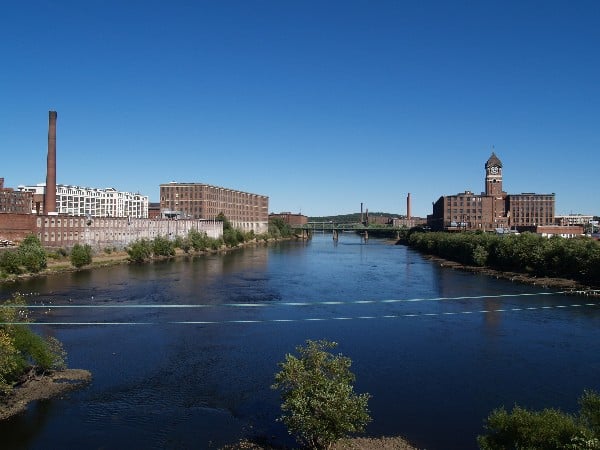
Merrimack River at Lawrence
Like other northeastern cities suffering from the effects of post-World War II industrial decline, Lawrence has often made efforts at revitalization, some of them controversial. For example, half of the enormous Wood Mill, powered by the Great Stone Dam and once the largest mills in the world, was knocked down in the 1950s. The Lawrence Redevelopment Authority and city officials utilized eminent domain for a perceived public benefit, via a top down approach, to revitalize the city throughout the 1960s. Known first as urban redevelopment, and then urban renewal, Lawrence's local government's actions towards vulnerable immigrant and poor communities, contained an undercurrent of gentrification which lies beneath the goals to revitalize Lawrence. There was a clash of differing ideals and perceptions of blight, growth, and what constituted a desirable community. Ultimately the discussion left out those members of the community who would be directly impacted by urban redevelopment.[11]
Under the guise of urban renewal, large tracts of downtown Lawrence were razed in the 1970s, and replaced with parking lots and a three-story parking garage connected to a new Intown Mall intended to compete with newly constructed suburban malls. The historic Theater Row along Broadway was also razed, destroying ornate movie palaces of the 1920s and 1930s that entertained mill workers through the Great Depression and the Second World War. The city's main post office, an ornate federalist style building at the corner of Broadway and Essex Street, was razed. Most of the structures were replaced with one-story, steel-frame structures with large parking lots, housing such establishments as fast food restaurants and chain drug stores, fundamentally changing the character of the center of Lawrence.
Lawrence also attempted to increase its employment base by attracting industries unwanted in other communities, such as waste treatment facilities and incinerators. From 1980 until 1998, private corporations operated two trash incinerators in Lawrence. Activist residents successfully blocked the approval of a waste treatment center on the banks of the Merrimack River near the current site of Salvatore's Pizza on Merrimack Street.
Recently the focus of Lawrence's urban renewal has shifted to preservation rather than sprawl.
Events of the 1980s and 1990s
Immigrants from the Dominican Republic and migrants from Puerto Rico began arriving in Lawrence in significant numbers in the late 1960s, attracted by cheap housing and a history of tolerance toward immigrants. In 1984, tensions between remaining working class whites and increasing numbers of Hispanic youth flared into a riot, centered at the intersection of Haverhill Street and Oxford Street, where a number of buildings were destroyed by Molotov cocktails and over 300 people were arrested.[12][13]
Lawrence saw further setbacks during the recession of the early 1990s as a wave of arson plagued the city. Over 200 buildings were set alight in an eighteen-month period in 1991–92, many of them abandoned residences and industrial sites.[14] The Malden Mills factory burned down on December 11, 1995. CEO Aaron Feuerstein decided to continue paying the salaries of all the now-unemployed workers while the factory was being rebuilt.[15]
Recent trends
A sharp reduction in violent crime starting in 2004[16] and massive private investment in former mill buildings along the Merrimack River, including the remaining section of the historic Wood Mill – to be converted into commercial, residential and education uses – have lent encouragement to boosters of the city. One of the final remaining mills in the city is Malden Mills. Lawrence's downtown has seen a resurgence of business activity as Hispanic-owned businesses have opened along Essex Street, the historic shopping street of Lawrence that remained largely shuttered since the 1970s. In June 2007, the city approved the sale of the Intown Mall, largely abandoned since the early 1990s recession, to Northern Essex Community College for the development of a medical sciences center, the construction of which commenced in 2012 when the InTown Mall was finally removed.[17][18] A large multi-structure fire in January 2008 destroyed many wooden structures just south of downtown.[19] A poor financial situation that has worsened with the recent global recession and has led to multiple municipal layoffs had Lawrence contemplating receivership.[20] On February 9, 2019, in recognition of the role the town has played in the labor movement, Senator Elizabeth Warren officially announced her candidacy for President of the United States in Lawrence.[21]
Gas explosion
On September 13, 2018, a series of gas explosions and fires broke out in as many as 40 homes in Lawrence, Andover, and North Andover. The disaster killed one resident and caused over 30,000 customers to evacuate their homes.[22]
Timeline
1845 Essex Company begins construction of dam and canal on Merrimack River.[23]
1846 Essex Company Machine Shop built. Lawrence Street Church organized.[24] Church of the Immaculate Conception established.[24]
1847 Town of Lawrence incorporated from Methuen and Andover; named after businessman Abbott Lawrence.[25] Lawrence Courier newspaper in publication.[26] Bellevue Cemetery established. Franklin Library Association formed.[27] First Baptist Church, First Free Baptist Church, First Unitarian Society, Church of the Good Shepherd, and First Methodist Episcopal Church established[24]
1848 Boston & Maine Railroad depot established in South Lawrence.[28] Lawrence Dam constructed across Merrimack River.[29] Bay State woollen mills begin operating.[30] St. Mary's Church organized.[24]
1849 Manchester and Lawrence Railroad begins operating. Lawrence Sentinel newspaper begins publication.[26] Central Church organized.[24] Atlantic Cotton Mills starts in business.[31] Lawrence Gas Company formed.[31] Lawrence Brass Band formed.[31]
1850 - Population: 8,282.
1851 - Grace Episcopal Church built.
1853 City of Lawrence incorporated as a municipal government. Charles S. Storrow becomes first city mayor.[32] Lawrence Duck Company in business.[31] Garden Street Methodist Episcopal Church organized as a congregation of the Methodist Episcopal Church.[24]
1854 Additional part of Methuen annexed to the City of Lawrence.[25] Pacific Mills starts operating bin business.[31][33] Lawrence Paper Company incorporated.[34][35]
1855 - Pemberton Company in business.[31]
1860 January - Pemberton Mill building collapse. Population according to decennial United States Census: 17,639.
1861 - Massachusetts state militia called up by Governor in response to proclamation by 16th President Abraham Lincoln of a state of rebellion in the South following firing on Fort Sumter in Charleston harbor in South Carolina Confederate forces on April 12. Sixth Regiment earliest to respond with men from Lawrence, Lowell, Methuen, Stoneham, Boston. Heads south by train and is attacked by mobs of Southern sympathizers in Baltimore along Pratt Street while being pulled through on horse cars and later marching between the President Street Station of the Philadelphia, Wilmington and Baltimore Railroad on the east of the harbor to the Camden Street Station of the Baltimore and Ohio Railroad on way to the national capital at Washington, D.C. on Friday, April 19. Four soldiers killed and numerous wounded and among Baltimorean civilians as city police and officials attempt to escort troops. Considered the "First Bloodshed of the Civil War".
Second Baptist Church established.[24]
1864 - Moseley Truss Bridge built.
1865 Eliot Congregational Church organized.[24] Arlington Mills in business.[36][37] Wright Manufacturing Co. formed.[24]
1867 - Lawrence Flyer and Spindle Works in business.[38]
1868 Lawrence Daily Eagle newspaper begins publication. South Congregational Church and First Presbyterian Church established.[24]
1871 Archibald Wheel Co. incorporated.[24] Parker Street Methodist Episcopal Church and St. Anne's Church organized.[24]
1872 - Free Public Library established[39]
1873 - St. Laurence's Church dedicated.[24]
1876 - YMCA formed.[24]
1877 Lawrence Bleachery established.[38] Tower Hill Congregational Church organized.[24]
1878 - German Methodist Episcopal Church organized.[24]
1879 Parts of Andover and North Andover annexed to Lawrence.[25] German Presbyterian Church organized.[24] Lawrence Bicycle Club formed.[24]
1880 Globe Worsted Co. incorporated.[24] Bodwell Street M.E. Church organized.[24]
1881 Lawrence Line Company incorporated.[31] Munroe Felt and Paper Company incorporated.[28] Merrimac Paper Company incorporated.[31]
1882 L'Institute Canadien Francais founded.[24] Stanley Manufacturing Co. incorporated.[24]
1884 - Emmons Loom Harness Company organized.[31]
1887 - Lawrence Experiment Station established by the Massachusetts State Board of Health.
1896 - High Service Water Tower built
1890 Public Library building constructed. Evening Tribune newspaper begins publication. July - Cyclone.[41]
1899 - 20,899 people employed in manufacturing in Lawrence.[42]
1905 - American Woolen Company builds Wood Mill.
1910 - Everett Mill constructed.
1912 - Famous nationally known 1912 Lawrence Textile Strike occurs with strife and casualties. Later known as the "Bread and Roses Strike".[43]
1918 - Central Bridge constructed.[41]
1919 - 30,319 people employed in manufacturing in Lawrence.[42]
1920 - Population: 94,270.
1927 - Stadium opens.
1931 - Boston & Maine Railroad depot active off Parker Street.
1934 Lawrence Municipal Airport established.[44] Walter A. Griffin becomes mayor.
1935 - Central Catholic High School opens.
1943 - Climatic Research Laboratory for United States Army in operation.
1966 - Daniel P. Kiley, Jr. becomes mayor.
1972 - John J. Buckley becomes mayor.
1975 - Paul Tsongas becomes Massachusetts's 5th congressional district representative.
1978 Immigrant City Archives at Lawrence History Center established for local history and culture with exhibitions.[45] Lawrence P. LeFebre becomes mayor.
1985 - Greater Lawrence Habitat for Humanity organized.[46]
1986 - Kevin J. Sullivan becomes mayor.
1991 - Northern Essex Community College active in Lawrence.
1995 - Malden Mills fire.
2001 - Michael J. Sullivan becomes mayor.
2004 - Notre Dame Cristo Rey High School opens. First observance of Civil War Weekend at central Compeigne Common in October remembering local casualties then nationally famous and considered first "martyrs for the Union" of the noted Sixth Massachusetts volunteer state militia regiment in infamous Baltimore riot of 1861 (also known as the "Pratt Street Riots") as the "First Bloodshed of the Civil War" on April 19, 1861. Various military reenactment units and heritage groups including from the Baltimore Civil War Museum at the historic President Street Station participate with memorial ceremonies at Soldiers Monument in Common and gravesites at historic Bellevue Cemetery, sponsored by the Lawrence Civil War Memorial Guard.
2005 - Lawrence (MBTA station) reopens for the Boston commuter train, subway and transit system.
2007 - Niki Tsongas becomes Massachusetts's 5th congressional district representative.
2010 Population: 76,377. William Lantigua becomes mayor of Lawrence, first of Hispanic ancestry.[47][48]
2012 School Superintendent convicted of fraud and embezzlement.[49] Centennial observed of infamous 1912 Lawrence Textile Strike, later known as "Bread and Roses" labor strife.[50]
History of Lawrence immigrant communities
Lawrence has been aptly nicknamed the "Immigrant City".[51] It has been home to numerous different immigrant communities, most of whom arrived during the great wave of European immigration to America that ended in the 1920s.
Immigrant communities, 1845–1920
Lawrence became home to large groups of immigrants from Europe, beginning with the Irish in 1845, Germans after the social upheaval in Germany in 1848, Swedes fleeing an overcrowded Sweden, and French Canadians seeking to escape hard northern farm life from the 1850s onward. A second wave began arriving after 1900, as part of the great mass of Italian and Eastern European immigrants, including Jews from Russia, Poland, Lithuania and neighboring regions. Immigration to the United States was severely curtailed in the 1920s with the Immigration Act of 1924, when foreign born immigration to Lawrence virtually ceased for over 40 years.[51]
In 1890, the foreign-born population of 28,577 was divided as follows, with the significant remainder of the population being children of foreign born residents: 7,058 Irish; 6,999 French Canadians; 5,131 English; 2,465 German; 1,683 English Canadian.[52] In 1920, toward the end of the first wave of immigration, most ethnic groups had numerous social clubs in the city. The Portuguese had 2; the English had 2; the Jews had 3; the Armenians, 5; the Lebanese and Syrians, 6; the Irish, 8; the Polish, 9; the French Canadians and Belgian-French, 14; the Lithuanians, 18; the Italians, 32; and the Germans, 47.[53] However, the center of social life, even more than clubs or fraternal organizations, was churches. Lawrence is dotted with churches, many now closed, torn down or converted into other uses. These churches signify, more than any other artifacts, the immigrant communities that once lived within walking distance of each church.[53][54]
Irish
Irish immigrants arrived in Lawrence at its birth, which coincided with the Great Potato Famine of the 1840s, the event that drove great numbers of Irish out of Ireland.The Great Stone Dam,constructed in from 1845–1848 to power the textile mills, was largely built by Irish laborers.The first Irish immigrants settled in the area south of the Merrimack River near the intersection of Kingston Street and South Broadway (In December, 1848, the Reverend James O'Donnell erected "old" St. Mary's Church.[26] In 1869,[27] the Irish were able to collect sufficient funds to form their own church, St. Patrick’s, on South Broadway.[24] Although immigration slowed down, The Irish community in Lawrence is still large.
Germans
The first sizable German community arrived following the revolutions of 1848.[51] However, a larger German community was formed after 1871, when industrial workers from Saxony were displaced by economic competition from new industrial areas like the Ruhr.[55] The German community was characterized by numerous school clubs, shooting clubs, national and regional clubs, as well as men's choirs and mutual aid societies,[55] many of which were clustered around the Turn Verein, a major social club on Park Street.[53] Germans had a considerable number of churches in Lawrence, including Church of the Assumption of Mary (German Catholic) parish formed in 1887 on Lawrence Street,[56] as well as a number of Protestant churches including The German Methodist Episcopal Church, Vine street, organized in 1878; and the German Presbyterian, East Haverhill street, organized 1872 from which the Methodist church split in 1878.[57]
Italians
Some Italian immigrants celebrated Mass in the basement chapel of the largely Irish St. Laurence O'Toole Church, at the intersection of East Haverhill Street and Newbury Street, until they had collected sufficient funds to erect the Holy Rosary Church in 1909 nearby at the intersection of Union Street and Essex Street.[53] Immigrants from Lentini (a comune in the Sicilian province of Syracuse) and from the Sicilian province of Catania maintained a particular devotion to three Catholic martyrs, Saint Alfio, Saint Filadelfo and Saint Cirino, and in 1923 began celebrating a procession on their feast day.[58] Although most of the participants live in neighboring towns, the Feast of Three Saints festival continues in Lawrence today. Many of the Italians who lived in the Newbury Street area had immigrated from Trecastagni, Viagrande, Acireale, and Nicolosi, Italy.
French Canadians
French Canadians were the second major immigrant group to settle in Lawrence. In 1872, they erected their first church, St. Anne's, at the corner of Haverhill and Franklin streets. Within decades, St. Anne's established a "missionary church", Sacred Heart on South Broadway, to serve the burgeoning Québécois community in South Lawrence. Later it would also establish the "missionary" parishes in Methuen: Our Lady of Mount Carmel and St. Theresa's (Notre-Dame du Mont Carmel et St-Thérèse). The French-Canadians arrived from various farming areas of Quebec where the old parishes were overpopulated: some people moved up north (Abitibi and Saguenay–Lac-Saint-Jean), while others moved to industrial towns to find work (Montreal, Quebec; but also in the United States). Others who integrated themselves into these French-Canadian communities were actually Acadians who had left the Canadian Maritimes of New Brunswick and Nova Scotia also in search of work.
Lebanese
Lawrence residents frequently referred to their Arabic-speaking Middle Eastern community as "Syrian". In fact, most so-called Syrians in Lawrence were from present-day Lebanon and were largely Maronite Christian.[53] Lebanese immigrants organized St. Anthony's Maronite Church in 1903,[59] and St. Joseph's Melkite Greek-Catholic Church, as well as St. George's Antiochian Orthodox Church.[53]
Jews
Jewish merchants became increasingly numerous in Lawrence and specialized in dry goods and retail shops. The fanciest men's clothing store in Lawrence, Kap's, established in 1902 and closed in the early 1990s, was founded by Elias Kapelson, born in Lithuania. Jacob Sandler and two brothers also immigrated from Lithuania in approximately 1900 and established Sandlers Department Store, which continued in business until 1978. In the 1880s, the first Jewish arrivals established a community around Common, Valley, Concord and Lowell streets. As of 1922, there were at least two noteworthy congregations, both on Concord Street: Congregation of Sons of Israel (Jewish), organized October 3, 1894. Synagogue on Concord street built in 1913; and Congregation of Anshea Sfard (Jewish), organized April 6, 1900. Synagogue on Concord street built in the autumn of 1907.[56] In the 1920s, the Jews of Lawrence began congregating further up Tower Hill, where they erected two synagogues on Lowell Street above Milton Street, as well as a Jewish Community Center on nearby Haverhill Street. All three institutions had closed their doors by 1990 as the remaining elderly members of the community died out or moved away.[53]
Polish
The Polish community of Lawrence was estimated to be only 600–800 persons in 1900. However, by 1905, the community had expanded sufficiently to fund the construction of the Holy Trinity Church at the corner of Avon and Trinity streets.[53] Their numbers grew to 2,100 Poles in 1910. Like many of their immigrant brethren from other nations, most of the Poles were employed in woolen and worsted goods manufacturing.[60]
Lithuanians
Lawrence had a sizable enough Lithuanian community to warrant the formation of both Lithuanian Catholic and Lithuanian National Catholic churches. St. Francis (Lithuanian Catholic Church) on Bradford Street was formed in 1903 by Rev. James T. O'Reilly of St. Mary's, in a building previously occupied by St. John's Episcopal Church.[61] The church closed in 2002, merging with Holy Trinity (Polish) and SS. Peter and Paul (Portuguese). Sacred Heart Lithuanian National Catholic Church was established about 1917 and located on Garden Street until its closure and sale in 2001.
English
A sizable English community, composed mainly of unskilled laborers who arrived after 1880, sought work in the textile mills where they were given choice jobs by the Yankee overseers on account of their shared linguistic heritage and close cultural links.
Yankee farmers
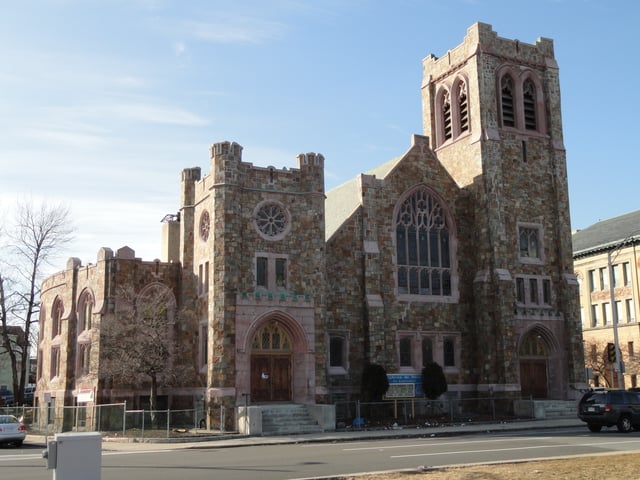
Lawrence Street Congregational Church
Not all immigrants to Lawrence were foreign-born or their children. Yankee farmers, unable to compete against the cheaper farmlands of the Midwest that had been linked to the East coast by rail, settled in corners of Lawrence. Congregationalists were the second Protestant denomination to begin worship in Lawrence after the Episcopalians, with the formation of the Lawrence Street Congregational Church in 1847,[62] [] and the first in South Lawrence, with the erection in 1852 of the first South Congregational Church on South Broadway, near the corner of Andover Street.[53] Baptist churches included The First Baptist Church, one of the first churches in Lawrence, which was organized in the spring of 1947 and was known as Amesbury Street Baptist Church. Second Baptist was organized September 6, 1860; its building dedicated in 1874.[56]
New immigrants, 1970 to present
Immigration of foreign born workers to Lawrence largely ceased in 1921 with the passage of strict quotas against immigrants from the countries that had supplied the cheap, unskilled workers. Although many quotas were lifted after the Second World War, foreign immigration to Lawrence only picked up again in the early 1960s with Hispanic immigrants from Cuba, Puerto Rico, the Dominican Republic and other Latin American countries. Immigrants from Southeast Asia, particularly Vietnam, have also settled in Lawrence.
Indicative of immigration trends, several Catholic churches now conduct masses in two or more languages. St. Patrick's Church, a Catholic church in Lawrence and once an Irish bastion, has celebrated Spanish masses on Sundays since 1999. A mass in Vietnamese is also offered every other week.[63] St. Mary's of the Assumption Parish is the largest Catholic parish in Lawrence by Mass attendance and number of registered parishioners. It has the largest multi-lingual congregation in the city and has been offering Spanish masses since the early 1990s.
Since the 1990s, increasing numbers of former Catholic churches, closed since the 1980s when their Irish or Italian congregations died out, have been bought by Hispanic evangelical churches.[64]
The 2000 Census revealed the following population breakdown, illustrating the shift toward newer immigrant groups:
Dominican Republic, 22%; Puerto Rican, 22%; other Hispanic or Latino, 12%; Irish, 7%; Italian, 7%, French (except Basque), 5%; Black or African American, 5%; French Canadian, 5%; English, 3%; Arab, 2%; German, 2%; Lebanese, 2%; Central American, 1%; Polish, 1%; Portuguese, 1%; Guatemalan, 1%; Vietnamese, 1%; South American, 1%; Spanish, 1%; Cambodian, 1%; Scottish, 1%; Cuban, 1%; Scotch-Irish, 1%; Ecuadoran, 1%.[65]
Geography
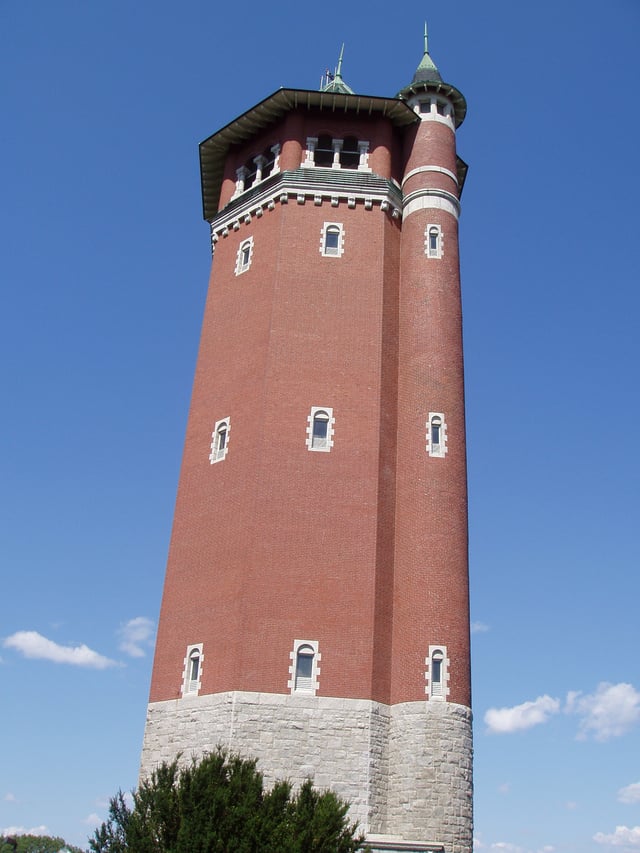
High Service Water Tower (1895), also called Tower Hill Water Tower, a notable eyecatcher or folly, named an American Water Landmark in 1979 by the American Water Works Association.
According to the United States Census Bureau, the city has a total area of 7.4 square miles (19 km2), of which 7.0 square miles (18 km2) is land and 0.4 square miles (1.0 km2) (6.07%) is water. Lawrence is on both sides of the Merrimack River, approximately 26 miles (42 km) upstream from the Atlantic Ocean. On the north side of the river, it is surrounded by Methuen. On the south side of the river, the town is bordered by North Andover to the east, and Andover to the south and southwest. Lawrence is approximately 30 miles (48 km) north-northwest of Boston and 27 miles (43 km) southeast of Manchester, New Hampshire.
Aside from the Merrimack River, other water features include the Spicket River, which flows into the Merrimack from Methuen, and the Shawsheen River, which forms the southeastern border of the city. Lawrence has two power canals that were formerly used to provide hydropower to the mills - one on the north bank of the river, the other on the south. Channeling water into these canals is the Great Stone Dam, which lies across the entire Merrimack and was, at the time of its construction in the 1840s, the largest dam in the world. The highest point in Lawrence is the top of Tower Hill in the northwest corner of the city, rising approximately 240 feet (73 m) above sea level. Other prominent hills include Prospect Hill, in the northeast corner of the city, and Mount Vernon, along the southern edge of the city. Most industrial activity was concentrated in the flatlands along the rivers. Den Rock Park, a wooded conservation district on the southern edge of Lawrence that spans the Lawrence-Andover town line, provides recreation for nature lovers and rock-climbers alike.[66] There are also several small parks throughout town.
Transportation
Lawrence lies along Interstate 495, which passes through the eastern portion of the city. There are three exits entirely within the city, though two more provide access from just outside the city limits. The town is also served by Route 28 passing from south to north through the city, and Route 110, which passes from east to west through the northern half of the city. Route 114 also has its western terminus at Route 28 at the Merrimack River. Lawrence is the site of four road crossings and a railroad crossing over the Merrimack, including the O'Leary Bridge (Route 28), a railroad bridge, the Casey Bridge (bringing Parker Street and access to Route 114 and the Lawrence MBTA station to the north shore), the Duck Bridge (which brings Union Street across the river), and the double-decked O'Reilly Bridge, bringing I-495 across the river.
Lawrence is the western hub of the Merrimack Valley Regional Transit Authority's bus service. It is also home to the Senator Patricia McGovern Transportation Center, home to regional bus service and the Lawrence stop along the Haverhill/Reading Line of the MBTA Commuter Rail system, providing service from Haverhill to Boston's North Station. Lawrence Municipal Airport provides small plane service, though it is actually in neighboring North Andover. Lawrence is approximately equidistant from Manchester-Boston Regional Airport and Logan International Airport. Future plans to revitalize the Manchester and Lawrence branch[67] to the north, leading to Manchester, New Hampshire, will allow the MBTA to operate rail service up to Manchester from Lawrence, in conjunction with Pan Am Freights.
Climate
Lawrence has a humid continental climate (Köppen climate classification Dfa), which is typical for the southern Merrimack valley region in eastern Massachusetts.
| Climate data for Lawrence, Massachusetts | |||||||||||||
|---|---|---|---|---|---|---|---|---|---|---|---|---|---|
| Month | Jan | Feb | Mar | Apr | May | Jun | Jul | Aug | Sep | Oct | Nov | Dec | Year |
| Average high °F | 33.9 | 36.4 | 45.2 | 56.6 | 68.2 | 77.3 | 82.6 | 81.1 | 72.9 | 62.5 | 50.7 | 38.1 | 58.8 |
| Average low °F | 15.4 | 16.9 | 27.0 | 37.1 | 47.3 | 56.6 | 62.3 | 60.6 | 52.2 | 41.6 | 33.0 | 21.4 | 39.3 |
| Average rainfall inches | 3.92 | 3.17 | 3.93 | 4.06 | 3.67 | 3.46 | 3.34 | 3.18 | 3.78 | 3.96 | 4.06 | 3.56 | 44.09 |
| Average high °C | 1.1 | 2.4 | 7.3 | 13.7 | 20.1 | 25.2 | 28.1 | 27.3 | 22.7 | 16.9 | 10.4 | 3.4 | 14.9 |
| Average low °C | −9.2 | −8.4 | −2.8 | 2.8 | 8.5 | 13.7 | 16.8 | 15.9 | 11.2 | 5.3 | 0.6 | −5.9 | 4.1 |
| Average rainfall mm | 100 | 81 | 100 | 103 | 93 | 88 | 85 | 81 | 96 | 101 | 103 | 90 | 1,120 |
Demographics
| Historical population | |||
|---|---|---|---|
| Census | Pop. | %± | |
| 1850 | 8,282 | — | |
| 1860 | 17,639 | 113.0% | |
| 1870 | 28,921 | 64.0% | |
| 1880 | 39,151 | 35.4% | |
| 1890 | 44,654 | 14.1% | |
| 1900 | 62,559 | 40.1% | |
| 1910 | 85,892 | 37.3% | |
| 1920 | 94,270 | 9.8% | |
| 1930 | 85,068 | −9.8% | |
| 1940 | 84,323 | −0.9% | |
| 1950 | 80,536 | −4.5% | |
| 1960 | 70,933 | −11.9% | |
| 1970 | 66,915 | −5.7% | |
| 1980 | 63,175 | −5.6% | |
| 1990 | 70,207 | 11.1% | |
| 2000 | 72,043 | 2.6% | |
| 2010 | 76,377 | 6.0% | |
| Est. 2018 | 80,376 | [1] | 5.2% |
| U.S. Decennial Census[68] | |||
According to the U.S. Census Bureau 2010 Census, the city's population is 76,377, the population density is 10,973.7 per square mile (4237/km2), and there are 27,137 households (25,181 occupied).
The racial makeup of the city in 2016 was 16.6% non-Hispanic white, 7.8% Black or African American, 2.8% Asian (1.2% Cambodian, 0.7% Vietnamese, 0.3% Pakistani, 0.2% Indian, 0.2% Chinese, 0.1% Korean), 0.4% American Indian or Alaskan Native, 0.0% Pacific Islander, 39.3% some other race, 2.7% two or more races, and 77.1% of the population is Hispanic or Latino (of any race) (47.0% Dominican, 21.7% Puerto Rican, 3.0% Guatemalan, 0.7% Salvadoran, 0.7% Spanish, 0.6% Cuban, 0.5% Ecuadorian, 0.5% Mexican, 0.2% Honduran, 0.2% Colombian, 0.1% Venezuelan, 0.1% Nicaraguan, 0.1% Peruvian).[69]
As of the census[70] of 2000, there were 72,043 people, 24,463 households, and 16,903 families residing in the city. The population density was 10,351.4 people per square mile (3,996.5/km2). There were 25,601 housing units at an average density of 3,678.4 per square mile (1,420.2/km2). The racial makeup of the city was 48.64% White (U.S. Average: 72.4%), 4.88% African American (U.S. Average: 12.3%), 2.65% Asian (U.S. Average: 3.6%), 0.81% Native American (U.S. Average: 0.1%), 0.10% Pacific Islander (U.S. Average: 0.1%), 36.67% from other races (U.S. Average: 5.5%), 6.25% from two or more races (U.S. Average: 2.4%).
There were 24,463 households where the average household size was 2.90 and the average family size was 3.46.
41.4% had children under the age of 18 living with them. (U.S. Average: 32.8%)
36.6% were married couples living together. (U.S. Average: 51.7%)
25.7% had a female householder with no husband present. (U.S. Average: 12.2%)
30.9% were non-families. (U.S. Average: 31.9%)
25.5% of all households were made up of individuals. (U.S. Average: 25.8%)
10.0% had someone living alone who was 65 years of age or older. (U.S. Average: 9.2%)
In the city, the population had a median age was 30.0 years (U.S. Average: 35.3):
32.0% under the age of 18
11.1% from 18 to 24
30.3% from 25 to 44
16.7% from 45 to 64
9.8% were 65 years of age or older.
For every 100 females, there were 91.6 males. For every 100 females age 18 and over, there were 86.8 males.
The median income for a household in the city was $25,983 (U.S. Average: $41,994), and the median income for a family was $29,809 (U.S. Average: $50,046). Males had a median income of $27,772 versus $23,137 for females. The per capita income for the city was $11,360. About 21.2% of families (U.S. Average: 9.2%) and 34.3% (U.S. Average: 12.4%) of the population were below the poverty line, including 31.7% of those under age 18 and 20.1% of those age 65 or over.
The Mayor of Lawrence, Daniel Rivera, said the city was "approximately 75% Spanish" following an incident where non English speaking callers were allegedly hung up on by a 911 operator.[71]
Government
Local
| Voter Registration and Party Enrollment as of October 17, 2018[72] | |||||
|---|---|---|---|---|---|
| Party | Number of Voters | Percentage | |||
| Democratic | 22,523 | 53.28% | |||
| Republican | 2,023 | 4.78% | |||
| Unenrolled | 17,321 | 40.97% | |||
| Minor Parties | 115 | 0.27% | |||
| Total | 42,269 | 100% | |||
Form of government: Plan B - "Strong mayor" - Mayor and city council, the councilors being elected partly at large and partly from districts or wards of the city. Party primaries prohibited.[73] [74] Lawrence has an established City Charter[75] and with a Mayor-council government. There are nine city councilors and six school committee members; most are elected by district; three city council members are elected at large. There are six districts in Lawrence and all elections are non-partisan. The Mayor serves as the seventh member and chair of the school committee. The city council chooses one of its number as president who serves as chair of the council. The city of Lawrence also elects three members to the Greater Lawrence Technical School Committee these members are elected at-large. City Council and Mayoral terms of office begin in the month of January.
| Lawrence City Council | Lawrence School Committee | Greater Lawrence Technical School Committee |
|---|---|---|
|
|
|
*** = President/Chair ** = Vice President/Vice Chair
Lawrence has its own police and fire departments, and Lawrence General Hospital provides ambulance services to the city.[76] The city also has its own public works and trash pickup departments.
State and federal
| Clerk of Courts: | Thomas H. Driscoll, Jr. (D) |
|---|---|
| District Attorney: | Jonathan W. Blodgett (D) |
| Register of Deeds: | M. Paul Iannuccillo (D) |
| Register of Probate: | Pamela Casey O'Brien (D)[77] |
| County Sheriff: | Kevin Coppinger (D) |
| State government | |
| State Representative(s): | Marcos Devers (D) Christina Minicucci (D) Frank A. Moran (D) |
| State Senator(s): | Barry Finegold (D) |
| Governor's Councilor(s): | Eileen Duff (D) |
| Federal government | |
| U.S. Representative(s): | Lori Trahan (D-3rd District), |
| U.S. Senators: | Elizabeth Warren (D), Ed Markey (D) |
Lawrence is one of Essex County's two county seats, along with Salem. As such, it is home to a juvenile, district and superior court, as well as a regional office of the Massachusetts Registry of Motor Vehicles. It is also home to the Lawrence Correctional Alternative Center, a regional alternative jail for low-risk offenders. It is not home to the county's sheriff or district attorney; they are in Middleton (home to the county's correctional facility) and Salem, respectively. The city is also covered by the Andover barracks of Troop A of the Massachusetts State Police, which serves much of the western Merrimack Valley and several towns just south of Andover.
Healthcare
Lawrence General Hospital[78] is the city's main hospital, providing service to much of the area south of the city. Other nearby hospitals are in Methuen, Haverhill and Lowell. The city also is served by the Greater Lawrence Family Health Center.[79] Guardian Ambulance was established in 1990 and incorporated in 1991 by local EMTs to serve the city during a downturn in the economy at that time. The station moved from the Tower Hill section to its current location on Marston Street in 1993.
Education
Public schools
The city has a public school system managed by Lawrence Public Schools. In November 2011, the Lawrence Public Schools was placed into state receivership by the Massachusetts Board of Elementary & Secondary Education.[84]
High schools
Charter schools
Private schools
Elementary schools
High schools
Central Catholic High School
Notre Dame Cristo Rey High School
Higher education
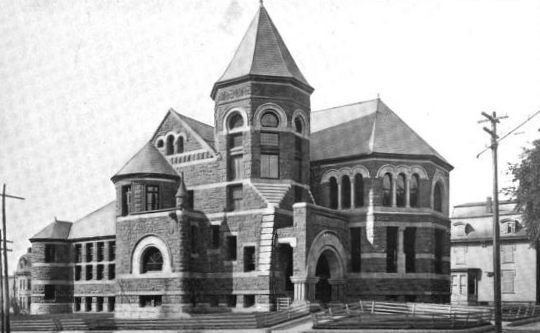
Lawrence public library, 1899
Public
Northern Essex Community College
Private
Cambridge College
Suffolk University (North Campus)
Library
Media and communications
Lawrence's main newspaper is The Eagle-Tribune,[95] one of the major newspapers for the Merrimack Valley that was founded in Lawrence in 1890 but later moved its facilities to the town of North Andover on Route 114. Lawrence is home to Rumbo (a bilingual English/Spanish paper) and Siglo 21[96] (a Spanish paper). Another newspaper closely covering Lawrence news is The Valley Patriot,[97] a monthly paper published in North Andover. The city has three AM stations, WNNW/800, WCAP/980, and WLLH/1400 (which is also dually licensed to Lowell, Massachusetts with a synchronous transmitter in that city); along with one FM station: WEEI-FM/93.7. WMFP is the only television station operating out of the city, and the city is considered part of the Boston television market.
Lawrence is served by Area codes 978 and 351. Originally a part of area code 617, it became part of area code 508 in 1988 before that, too, was split, with 978 covering the northern half of the old area code. Area code 351 is considered an overlay code.
Economy
New Balance has a shoe manufacturing plant in Lawrence, one of five plants operating in the US.[98]
Charm Sciences, which manufactures test kits and systems for antibiotic, veterinary drugs, mycotoxins, pesticides, alkaline phosphatase, pathogens, end-product microbial assessment, allergen control, and ATP hygiene, has a laboratory in Lawrence.
Lawrence General Hospital, founded in 1875, is located near downtown.
Points of interest
Bellevue Cemetery
Campagnone Common
Essex Art Center[99]
Great Stone Dam
High Service Water Tower and Reservoir
Lawrence Community Works[100]
Lawrence Experiment Station
Lawrence Heritage State Park
Lawrence History Center[101]
Lawrence Public Library
Sacred Heart Parish Complex
Saint Alfio Society (Feast of the Three Saints)[102]
Semana Hispana (Hispanic Week)[103]
Veterans Memorial Stadium
Notable people
A. J. Antoon, Tony Award-winning theatre director
Al Bernardin, inventor of the Quarter Pounder[104]
Leonard Bernstein, composer, conductor of New York Philharmonic, winner of a Tony Award and 18 Grammy Awards, born in Lawrence
Johnny Broaca, professional baseball player
Garrett Caples, famous poet
Doc Casey, professional baseball player
James A. Champy, author, management expert, retired CEO
Ed Coleman, radio reporter, host for the New York Mets
John William Comber, Catholic missionary and bishop
Elaine Comparone, harpsichordist
Bill Cronin, American football player
Irene Daye, jazz singer
Ferdinand Waldo Demara, "The Great Impostor"
Anthony DeSpirito, jockey
Marcos Devers, first Dominican-American to serve as a mayor in the U.S.
William E. Donovan, MLB pitcher and manager
Sully Erna, Godsmack lead singer
Aaron Feuerstein, one of the CEOs of Malden Mills; known for his generosity, for which he was awarded the Peace Abbey Courage of Conscience Award
Joseph D. FitzGerald, president of Fairfield University (1951–1958)
Jocko Flynn, MLB pitcher
Robert Frost, iconic poet, winner of four Pulitzer Prizes and a Congressional Gold Medal, a graduate of Lawrence High School
Ziwe Fumudoh, comedian and comic writer
Robert Goulet, Grammy-winning singer and Tony-winning actor, born in Lawrence
Steve Holman, voice of the Atlanta Hawks
Nicky Jam, real name Nick Rivera Caminero, rapper and reggaeton artist, lived in Lawrence until the age of 11
Francis Kilcoyne (died 1985), President of Brooklyn College
William S. Knox, US congressman from 1895 to 1903
Thomas J. Lane, U.S. congressman from March 4, 1941 to March 3, 1963
Abbott Lawrence, founder of Lawrence, U.S. congressman, and ambassador to the United Kingdom
Anna LoPizzo, striker killed during the Lawrence textile strike
Sal Maccarone, sculptor
Ray MacDonnell, actor
Robert S. Maloney, U.S. congressman from 1921 to 1923
Frank McManus, MLB catcher
Robbie Merrill, Godsmack bassist
Paul Monette, author, poet, and activist
George Moolic, professional baseball player
Ray Mungo, author of 18 books and co-founder of Liberation News Service
Jane Ellen "Bonnie" Newman, executive dean of Harvard's Kennedy School and president of the University of New Hampshire
John O'Connell, professional baseball player
Henry K. Oliver, Treasurer of Massachusetts from 1886 to 1889
Endicott Peabody, Governor of Massachusetts from 1963 to 1965
Leo Z. Penn, actor and director, father of Sean Penn
Joe Perry, guitarist of Aerosmith
Raymond Preston, NFL linebacker
William Quinlan, NFL defensive end
Gil Reyes, boxer, WBA, Fedecentro welterweight champion
William Herbert Rollins, pioneer in field of radiation protection
Dave Rozumek, NFL player
William A. Russell, U.S. congressman from 1879 to 1885
James Shannon, Attorney General of Massachusetts and CEO of National Fire Protection Association
Edgar J. Sherman, Attorney General of Massachusetts and Associate Justice of the Massachusetts Superior Court
Bethann Siviter, expatriate British nurse leader and author
John K. Tarbox, U.S. congressman from 1875 to 1877 and Mayor of Lawrence from (1873–1875)
Ernest Thayer, writer and poet, Casey at the Bat
Thelma Todd, actress
Emily Greene Wetherbee, poet and educator
John E. White, Auditor of Massachusetts July 6, 1911 to 1914
Michael C. Wholley, general counsel for NASA
William M. Wood, co-founder of American Woolen Company
See also
1912 Lawrence textile strike
American Automobile and Power Company
American Woolen Company
Bread and Roses
Malden Mills
Noack Organ Company
Olive Baptist Church
Pemberton Mill
List of mill towns in Massachusetts



